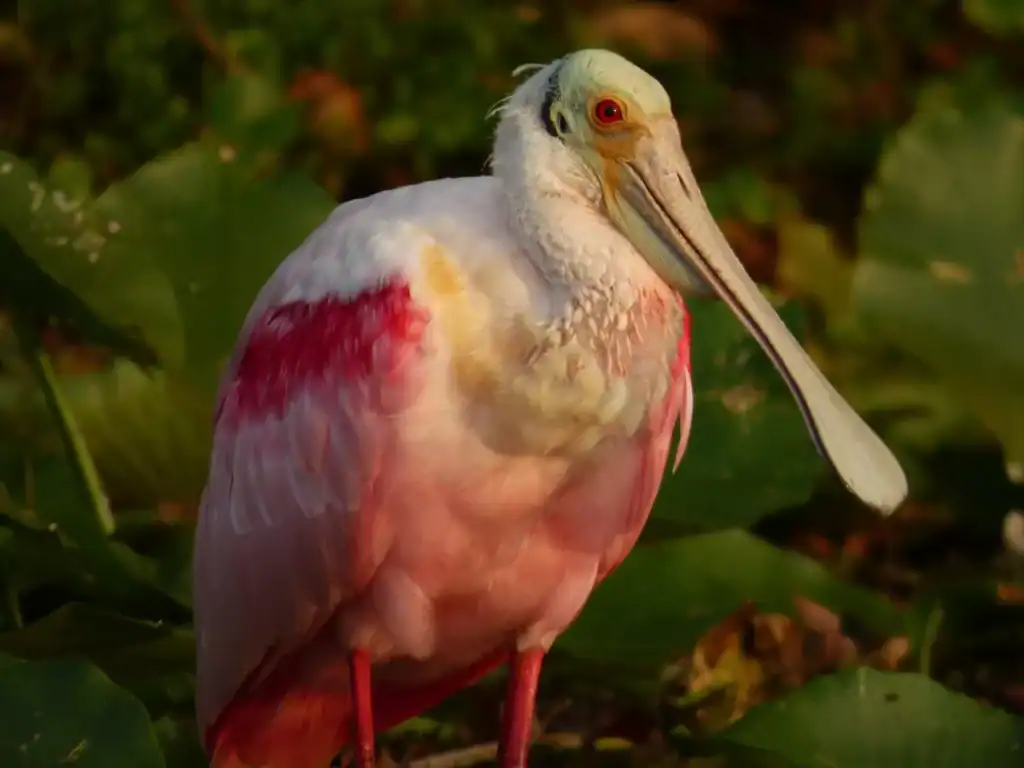Seeing Pink: The Roseate Spoonbill in Southeast Georgia
It’s a pink balloon!
It’s a flamingo!
No, it is a roseate spoonbill.

This time of year, we are likely to see a flash of pink in the sky or along our marshes as roseate spoonbills travel to our area to nest. How do these avians get their distinctive plumage, and where can we find them? Discover the details below.
La Vie en Rose
Roseate spoonbills, with their bright pink body and crimson shoulder feathers, are the most colorful wading birds nesting in the United States. They are typically found in Florida, Texas, and southwest Louisiana in coastal marshes, lagoons, mudflats, and mangrove keys. In these shallow muddy waters, they forage by sweeping their bills from side to side with mandibles slightly open, detecting prey by feel.
Their diet includes small fish, such as minnows, and aquatic invertebrates such as shrimp, crayfish, crabs, aquatic insects (especially beetles), mollusks, and slugs. It is believed they receive their bright coloring from the pigments of the crustaceans they consume. They can also eat some plant material, including roots and stems of sedges.
Birds of a Feather
They are social birds and often feed, roost, and fly in formation together. Generally, they are a silent species, but on their breeding grounds and sometimes while feeding, they can be heard uttering a low, almost chuckling series of grunts.
Spoonbills breed mainly during the winter in Florida. In courtship, male and female first interact aggressively and later perch close together, present nest material to each other, dance, and clap. They then cross and clasp bills, which strengthen their pair bond. They nest in mangroves, trees, or shrubs usually five to fifteen feet above the ground or water. The females usually build the nests, while the males bring the materials to form a bulky platform of sticks with a deep hollow in the center lined with twigs and leaves.
Roseate spoonbills nest in colonies and generally lay a clutch of one to five eggs. Both parents share incubation duties, which last about 22 to 24 days, until the eggs hatch between late April and early May. Both also feed their young by dribbling regurgitated material into the baby’s upturned bill. By six weeks, the fledglings will have left the nest.
Depradation
Until the mid-1800s, roseate spoonbills were more abundant and widespread than they are today, especially across much of south Florida. Between 1850 and the 1890s, they were hunted for their feathers for use in hats and women’s fashion. This practice led to a significant contraction in their population until by 1936, as few as 15 nesting pairs were documented in Florida Bay only.
Fortunately, by the 1940s, hunting this species for its plumage became illegal when major population declines were noted. In the late 1960s, roseate spoonbills’ numbers in Florida began to increase dramatically until 2,400 pairs were documented by the late 1970s. By the early 2000s, their range had spread to the east coast, such as to the Kennedy Space Center and the St. Augustine Alligator Farm Zoological Park.
Coming Home to Roost
Roseate spoonbills here in Southeast Georgia are a new development. They were not spotted farther north than St. Augustine until they were found in St. Marys at the “Rookery,” the former Gilman Paper Mill site, in 2010. A roseate spoonbill nest discovered here in June 2011 is the first confirmed record of their nesting in the state of Georgia and represents the northern-most nesting for this species on the Atlantic Coast.
These days, roseate spoonbills are still uncommon and local, although we believe there are about 11,000 adults in North America. In the United States, approximately 3,000 pairs nest in Texas, about 1,500 in Louisiana, and 1,100 in Florida, and their range continues to expand. Recently, they have been spotted as far north as Maine and Michigan.
Fortunately, although the largest threat to this species today is habitat destruction, their conservation status is not of concern. This means we have a high chance of spotting them in our area this spring. Until the Rookery is opened to the public, look out for them along the St. Marys waterfront, at Crooked River State Park, or on Cumberland Island. Enjoy the fact that spring colors are not just in the flowers – they are in the avian community as well!
Try your hand at seeing a roseate spoonbill with us on our Cumberland Island Walking Tour: Haunting Ruins and Wild Horses or our Fugitives, Fighters, and Fudge: St Marys Walking Tour!


